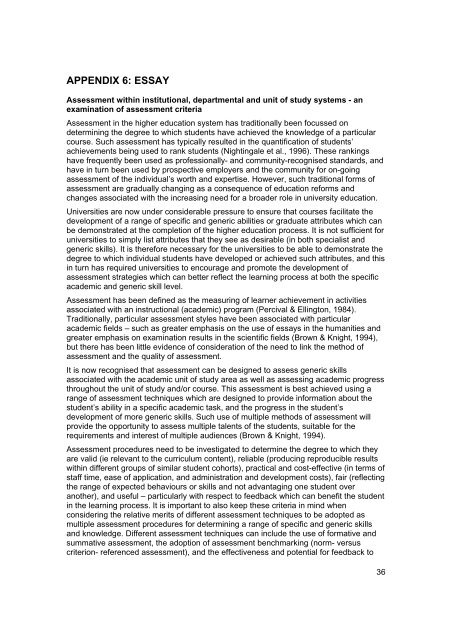Staff Information & Teaching Guide - Swinburne University of ...
Staff Information & Teaching Guide - Swinburne University of ...
Staff Information & Teaching Guide - Swinburne University of ...
You also want an ePaper? Increase the reach of your titles
YUMPU automatically turns print PDFs into web optimized ePapers that Google loves.
APPENDIX 6: ESSAY<br />
Assessment within institutional, departmental and unit <strong>of</strong> study systems - an<br />
examination <strong>of</strong> assessment criteria<br />
Assessment in the higher education system has traditionally been focussed on<br />
determining the degree to which students have achieved the knowledge <strong>of</strong> a particular<br />
course. Such assessment has typically resulted in the quantification <strong>of</strong> students’<br />
achievements being used to rank students (Nightingale et al., 1996). These rankings<br />
have frequently been used as pr<strong>of</strong>essionally- and community-recognised standards, and<br />
have in turn been used by prospective employers and the community for on-going<br />
assessment <strong>of</strong> the individual’s worth and expertise. However, such traditional forms <strong>of</strong><br />
assessment are gradually changing as a consequence <strong>of</strong> education reforms and<br />
changes associated with the increasing need for a broader role in university education.<br />
Universities are now under considerable pressure to ensure that courses facilitate the<br />
development <strong>of</strong> a range <strong>of</strong> specific and generic abilities or graduate attributes which can<br />
be demonstrated at the completion <strong>of</strong> the higher education process. It is not sufficient for<br />
universities to simply list attributes that they see as desirable (in both specialist and<br />
generic skills). It is therefore necessary for the universities to be able to demonstrate the<br />
degree to which individual students have developed or achieved such attributes, and this<br />
in turn has required universities to encourage and promote the development <strong>of</strong><br />
assessment strategies which can better reflect the learning process at both the specific<br />
academic and generic skill level.<br />
Assessment has been defined as the measuring <strong>of</strong> learner achievement in activities<br />
associated with an instructional (academic) program (Percival & Ellington, 1984).<br />
Traditionally, particular assessment styles have been associated with particular<br />
academic fields – such as greater emphasis on the use <strong>of</strong> essays in the humanities and<br />
greater emphasis on examination results in the scientific fields (Brown & Knight, 1994),<br />
but there has been little evidence <strong>of</strong> consideration <strong>of</strong> the need to link the method <strong>of</strong><br />
assessment and the quality <strong>of</strong> assessment.<br />
It is now recognised that assessment can be designed to assess generic skills<br />
associated with the academic unit <strong>of</strong> study area as well as assessing academic progress<br />
throughout the unit <strong>of</strong> study and/or course. This assessment is best achieved using a<br />
range <strong>of</strong> assessment techniques which are designed to provide information about the<br />
student’s ability in a specific academic task, and the progress in the student’s<br />
development <strong>of</strong> more generic skills. Such use <strong>of</strong> multiple methods <strong>of</strong> assessment will<br />
provide the opportunity to assess multiple talents <strong>of</strong> the students, suitable for the<br />
requirements and interest <strong>of</strong> multiple audiences (Brown & Knight, 1994).<br />
Assessment procedures need to be investigated to determine the degree to which they<br />
are valid (ie relevant to the curriculum content), reliable (producing reproducible results<br />
within different groups <strong>of</strong> similar student cohorts), practical and cost-effective (in terms <strong>of</strong><br />
staff time, ease <strong>of</strong> application, and administration and development costs), fair (reflecting<br />
the range <strong>of</strong> expected behaviours or skills and not advantaging one student over<br />
another), and useful – particularly with respect to feedback which can benefit the student<br />
in the learning process. It is important to also keep these criteria in mind when<br />
considering the relative merits <strong>of</strong> different assessment techniques to be adopted as<br />
multiple assessment procedures for determining a range <strong>of</strong> specific and generic skills<br />
and knowledge. Different assessment techniques can include the use <strong>of</strong> formative and<br />
summative assessment, the adoption <strong>of</strong> assessment benchmarking (norm- versus<br />
criterion- referenced assessment), and the effectiveness and potential for feedback to<br />
36

















